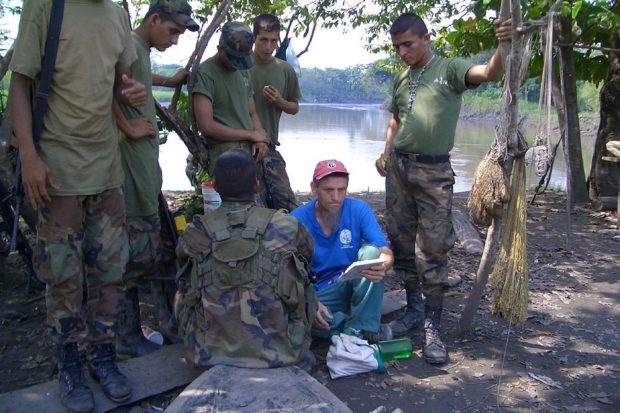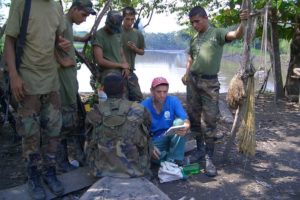
By Richard Stone

In April, Fresno played host to an artist who constructed a model drone to remind us of the lethal capabilities of these pilotless aircraft. In May, we had the opposite: Jim Fitz, a member of Christian Peacemaker Teams (CPT) came to town presenting his organization’s model for establishing peace in the midst of violence.
Jim (I presume a first-name basis after hosting him for three days) has gone to Colombia nine times in the past 12 years, two months each visit, as a member of a CP team—usually 6–10 people at a time—that has kept a continuous presence there to protect groups of indigenous farmers from losing land or being victims of violence.
In a country ravaged by civil war, there are three militarized groups: rebels (such as the FARC [Revolutionary Armed Forces of Colombia—People’s Army]) in uprising against the oligarchic and (of course) U.S.-supported government; the official Colombian army; and paramilitary mercenaries hired by the wealthy elite to further their interests. Any two of these may be in league or in conflict at any given time, and the unarmed farmers are at the mercy of all.
Responding to a request for help from the farmers, the CPT sent in a team to literally “get in the way of violence”: to bear witness, to speak against violence to those with weapons, to serve as a physical shield if necessary. The task of establishing a presence, making contacts with all sides, becoming identified as peacemakers and not interventionists, to establish trust—this may be low-key activity but is certainly at least a modest form of heroism.
Jim himself is a modest man, a farmer by trade, and still evincing the slow speech and Pennsylvania Dutch accent of his ancestry, the Church of the Brethren, close relatives of the Amish and Mennonites. As Jim tells it, he had drifted from his religious roots and considered himself an agnostic.
But 12 years ago, he found on the Internet an appeal from the CPT for volunteers to go to Colombia for what it termed “dangerous work.” Jim says that his earliest religious training had been to “lay down your life for peace,” and this request—in virtually a conversion experience—revitalized his spirituality and told him this is what he was meant to do. He adds, “I expected my wife and family and friends to tell me I was crazy, but they all said, ‘Do what you need to do.’ And this has become my life now.”
(It should be noted that his was not all new terrain. Jim had previously spent three years in Bolivia as a community organizer with the Brethren Volunteer Service and had come to feel that he half-belonged in Latin America.)
Asked about training for volunteers, Jim says that newbies typically spend about a month studying language, the biblical basis for peacemaking, mediation techniques and nonviolent responses to threats of violence. “We do a lot of role-playing,” he says.
Training also emphasizes that teams are not there to do social work or economic development. “We go only to protect the unarmed from the armed,” says Jim. And what protects the team? “Our skin color and national affiliation and—I’ve come to believe more and more—the prayers that people make on our behalf.”
Over his years of participation on this particular team, Jim has seen the establishment of some supportive connections in the U.S. Embassy. (“There are actually some staff there who want to help.”) Also, the indigenous people have embraced their right to report illegal activities, and access to media has enabled exposure of wrongdoing. “We CPT-ers go out in the field wearing our red hats and blue shirts for two days at a time to observe and check in, then spend two days on the computer relating our news and writing letters soliciting help.”
His commitment to this work is bolstered by having been told numerous times, “If you weren’t here we’d have had to abandon the farms.” And now, local churches and support groups have the courage to go into previously forbidden territory—so much so that schools have reopened and the original target group of farmers is safe. The team has been able to move on to other locales.
“Far from being a sacrifice,” says Jim, “living out my faith by bringing a bit of peace and justice to the world has been the richest time of my life.”
(Author’s note: An interview I taped with Jim can be heard on KFCF 88.1 FM on June 11 at 3 p.m. on Stir It Up. For more information, contact Jim at jimfitz2@gmail.com or via his Web site, www.jimspeacemaking.org. Besides Colombia, there have been CP teams in Haiti, Chiapas, Iraq and Israel/Palestine.)
*****
Richard Stone is on the boards of the Fresno Center for Nonviolence and the Community Alliance and author of the book Hidden in Plain Sight. Contact him at richard2662559@yahoo.com.
